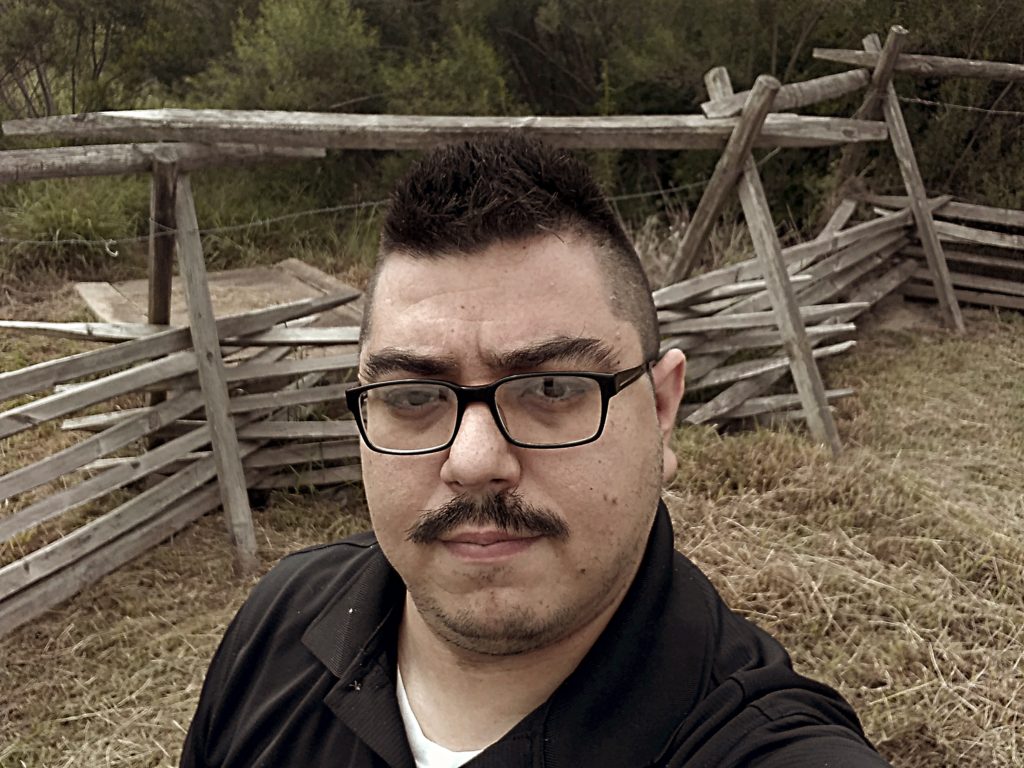Mi Testimonio: My Queer Latinx Experience at the Border
By Arturo Trevino Jr.
Sitting across from my sister, my eyes linger, I try not to break contact from what unfolds in front of me. Denim, boots, a belt buckle, rough-looking hands, and smiles. Their hats were placed on the side of the table. Sombrero on, he dawns the most gorgeous smile. I need to capture every detail. Click – I take a mental image. His warm grin welcomes the visit of his lover, he sits across from him and grabs his hand and squeezes it. I saw it! The kindling twinkle and the contact. This was the subtle code between lovers and not brothers. No hanky code, avid loving eye contact, and touch. That year in San Antonio, Texas, I knew my interest, I knew my queerness. The phrase it takes one to know one never had crystallized into my persona until that moment.
Driving across the Rio Grande Valley, we are at the cusp, the edge of the barbwire between Mexico and the United States. We are a borderland; we tread in a territory that is neither 100% Mexican nor 100% American. The tamales and tacos tectonically shift culturally through the avenues of the palatable spaces. In the streets, viscous to the mainstream of the East, people don bags made of cloth and nylon pulling a multiplicity of food from the corner store heading back to Matamoros, Tamaulipas, México. Our consumers, our neighbors to the South. In 2018, a safe space, Studio 69, closed its doors in my city. The closest fraternity for any queer person on this side of the river was to drive an hour to PBDs. Queer solidarity. In the most intimate circles, interactions amongst the Queendom of sisters relegated to the nearby bar being substituted as the new safe space. The latest trend in the Rio Grande Valley was safety in numbers. My queer solidarity treaded a sonic landscape where I was hugged tightly by chords, electric sounds, a twang of a guitar string, and a country fiddle’s resonance. My personal taste of music is an amalgamation of genres, yet I’ve been viscously pushing back against my roots. The vivacious taps of boots in Quinceñeras and weddings of family and family friends, the presence of Tejano queers, who were these women and men, and where were they?
I don’t know if we have a quintessential sonic identity as queers in this area. The resulting immersion of electronic dance music and a shift to 70s music makes me stereotypically shift to what the media portrays as what every LGBT person should be.
My sonic awakening happened when I started listening to Drake Jensen. I was looking at some other queer songs, of which I realized a lack of visibility in my neck of the woods. I fell in love with Jensen’s music! There was something about his music that made me live the music. The lyrical storytelling delved into my psyche palpitating lived experiences. This IS my jam. It’s incredible how an artist from one side of the border met the ears of another person along with another one. Immersing myself in this music, I was home.
I’ve been looking for this sonic solidarity along the Rio Grande Valley, and I am still searching. When I go to these weddings and quinceñeras, people dance their cumbias, huapangos the cultural variation of line dancing, I queer the music I hear by taking on the role of the male and female. I visualize the story as the lyrics unfold, I conquest my love, and courted and subdued by my invisible lover. This feeling of taking on both roles, shifts as I begin to take on the role of a dance partner. I wonder if this is what it feels like in an encuentro vaquero. A shifting of boots, the sweat from the hands firmly assuring his or her partner that I am here with you and I am here for you. What a sight it would be to see these couples dance into the moonlight.
It’s been years since I’ve worn boots. The last time I wore them I was 12 years old, and always questioned my parents why I needed a pair of boots. I felt like the oddball out with them on. A cowboy version of puss in boots? I am not the rough, football playing type of guy, I felt like an imposter in these boots. I looked inwardly for the longest time, where did this shame stem from? Where did my sonic shame for my culture’s music come from? Perhaps it was the deeper visual power that came from the image of the cowboy, the charro, el ranchero, the rancher. The ruggedness had a visual sexual subcomponent I didn’t know how to face when I was young.
Today, I can explore my Tejano, queer, Norteño sonic and sexual side on my terms. My musical immersion is no longer a tasting but a plethora at the buffet table. What grounds me are the storytellers. Even the wildest of broncos need to settle down and a rugged cowboy can tie me down. I immerse into my sonic landscape, and in this vast space at the border between Mexico and the United States, I find my way home.

Arturo Trevino Jr. lives in Brownsvile, TX, in the Rio Grande Valley. He lives by writing, sharing, performing, educating, and bending spines of paperback books as he finishes his masters in music.